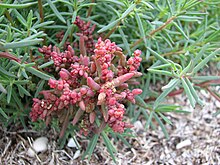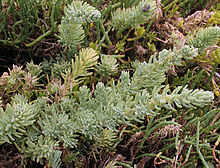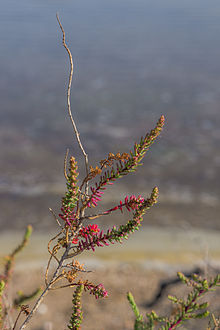Sod (genus)
| Sod | ||||||||||||
|---|---|---|---|---|---|---|---|---|---|---|---|---|

Beach sod ( Suaeda maritima ) |
||||||||||||
| Systematics | ||||||||||||
|
||||||||||||
| Scientific name | ||||||||||||
| Suaeda | ||||||||||||
| Forssk. |
The sods or Salzmelden ( Suaeda ) are a genus of plants from the subfamily Suaedoideae in the family of the foxtail plants (Amaranthaceae). The German common name soda refers to the earlier use for the production of soda .
description

Vegetative characteristics
The sod species are annual or perennial , herbaceous plants , semi-shrubs or shrubs . The blue-green or green parts of the plant can be bald or hairy. The stems grow prostrate, ascending or upright, they are simple or branched and not fleshy.
The mostly alternate, sedentary or very short stalked leaves are fleshy ( succulent ). Their entire leaf blade is linear, lanceolate or elliptical in shape, with a blunt, rounded or pointed tip. In cross-section, the leaves are flat, half-petiole or petiole-round.
Inflorescences and flowers
The flowers sit in ear-like , more rarely in racemose inflorescences to one to twelve kneaded in the axils of the leaf-like bracts . There are two to three (rarely up to seven) very small, dry-skinned prophylls of oval to lanceolate shape.
The flowers are hermaphroditic or unisexual. The inflorescence consists of five mostly fleshy, more or less interconnected tepals , which outlast the anthesis . There are (rarely two to) five stamens , the anthers of which usually protrude from the flower. The ovary bears two to three (rarely five) scars .
Fruits and seeds
The fruit remains enclosed by the inwardly curved, often hood-shaped, contracted bloom cladding leaves. On the outside, the tepals can thicken or have wing-like or horn-like outgrowths. The fruit contains a horizontal or vertical seed of spherical to flattened shape. The individual species differ in terms of color and surface structure of the seed coat. The embryo is rolled up in a spiral, there is little or no nutrient tissue.
Chromosome numbers
The basic chromosome number is x = 9.
Photosynthetic pathway
The Suaeda species of the Salsina and Schoberia sections are C 4 plants with a typical wreath anatomy. In the species of the Borszczowia section , the C 4 synthesis pathways take place in a single cell type without a coronal anatomy, ie without spatial distribution (“single cell C 4 ”) . All other sections are C 3 plants .
Occurrence
The genus Suaeda are common worldwide. The Suaeda species inhabit wetlands with salty or alkaline soils , especially on the beaches of the coast. They can also be found in suitable locations in the interior of the country and grow, for example, at salt springs , in salty floodplains , steppe deserts and river and lake banks in dry climates.
The sod species occurring in Central Europe belong to Kapralov et al. (2006) of the subgenus Brezia . In Germany only the beach sod ( Suaeda maritima ) is native. In Austria there are also the small salt report ( Suaeda prostrata ) and the large salt report ( Suaeda pannonica ).






Systematics
The genus Suaeda was first published in 1776 by Peter Forsskål in Onomatologia botanica completa, or Complete Botanical Dictionary , Frankfurt 8, p. 797. The scientific genus name Suaeda comes from the Arabic “suaed” for black, the Arabic name for Suaeda vera . Type species is Suaeda vera Forssk. ex JFGmel.
Synonyms for Suaeda Forssk. ex JFGmel. (nom. cons.) are Brezia Moq. , Calvelia Moq. , Chenopodina Moq. , Dondia Adans. , Helicilla Moq. , Lerchia Zinn , Schanginia C.A.Mey. and Schoberia C.A.Mey. . The genera Alexandra Bunge and Borszczowia Bunge are also assigned to Suaeda after phylogenetic studies .
Suaeda is considered a "difficult" genus by botanists, as there are hardly any stable characteristics for classification. Many species are extremely variable, although it is unclear what proportion is due to environmental conditions or genetic differences. Especially the widespread species Suaeda maritima , Sueada calceoliformis and Suaeda nigra are very polymorphic. To determine it, flowers (for the shape of the ovary) and ripe fruits are required. In the case of herbarium, the fleshy parts of the plant lose some of their characteristic properties when they dry.
The Suaeda belongs to the tribe Suaedeae in the subfamily Suaedoideae within the foxtail family (Amaranthaceae). It used to be part of the goosefoot family (Chenopodiaceae), this family has now been incorporated into the Amaranthaceae family.
According to phylogenetic studies by Schütze et al. (2003) and Kapralov et al. (2006) the genus Suaeda is further subdivided into two sub-genera with several sections and includes around 82 species, here is a selection:
- Subgenus Brezia (Moq.) Friday & Sagittarius :
- Section Brezia (Moq.) People :
- Suaeda australis (R.Br.) Moq. : It occurs in East and Southeast Asia and Australia and grows on the edge of mangrove forests, on sandy beaches and sea coasts.
- Suaeda calceoliformis (Hook.) Moq. : It iswidespreadfrom Alaska and Canada to Mexico and grows on moist salt soils, also in disturbed areas and roadsides.
- Suaeda corniculata (CAMey.) Bunge : It occurs from southern and southeastern Europe via Central Asia to East Asia (China) and grows in salt deserts, on lake and river banks.
- Suaeda crassifolia Pall. : It occurs from Southeast Europe (Lower Volga Region) across Southwest Asia (Caucasus, northern Iran) and Central Asia to the southern part of the Chinese Autonomous Region of Xinjiang . It inhabits salt deserts, rivers and lakes.
- Suaeda heterophylla Bunge ex Boiss. : It occurs from Southeast Europe (Lower Volga Region ) across Southwest Asia ( Caucasus , Iran ) and Central Asia to East Asia (China). It grows on strongly saline-alkaline soils in steppe deserts, on river and lake banks and in fields.
- Suaeda kossinskyi Iljin : It occurs from Southeast Europe (Lower Volga Region) via Central Asia to the Chinese Autonomous Region of Xinjiang and grows on strongly saline-alkaline soils.
- Beach sod ( Suaeda maritima (L.) Dumort. ): It is widespread on the coasts of Europe, the temperate regions of Asia, in northern Africa and in North America, and also inhabits inland saltpans .
- Suaeda occidentalis (S.Watson) S.Watson : It is widespread in North America and inhabits moist salt soils.
- Gross-Salzmelde ( Suaeda pannonica Beck ), a Pontic - Pannonian species, which has its western border in Burgenland ( Seewinkel ).
- Suaeda patagonica Speg.
- Klein-Salzmelde ( Suaeda prostrata Pall. ): It is a Pannonian-Pontic-South Siberian species that occurs in locations rich in sodium chloride from Austria (Burgenland) through South and Southeast Europe, Southwest and Central Asia to East Asia (China).
- Suaeda spicata (Willd.) Moq. : The home is Spain and the Balearic Islands .
- Suaeda chujensis Lomon. & Friday : It was first described in 2003. It only thrives in the semi-deserts of the high mountains in the Russian Altai and in the Gobi-Altai in Mongolia.
- Section Brezia (Moq.) People :
- Subgenus Suaeda
- Section Alexandra (Bunge) Kapralow et al. : It contains only one type:
- Suaeda lehmannii (Bunge) Kapralov, Akhani & EHRoalson (Syn .: Alexandra lehmannii Bunge ): It is located in the Aral region of Central Asia.
- Section Borszczowia (Bunge) Friday & Sagittarius : It contains only one species:
- Suaeda aralocaspica (Bunge) Friday & Sagittarius
- Physophora Ilyin's section
- Suaeda ifniensis Caball. ex Maire : It occurs in Morocco.
- Suaeda palaestina Eig & Zohary : It occurs in Sicily, Crete, Egypt, Libya, on the Sinai Peninsula, in Israel and Jordan.
- Suaeda physophora Pall. : It occurs from southeastern Europe (Caucasus region) to the Chinese provinces of Gansu , Xinjiang and grows in steppe deserts, on salty dry slopes and in alluvial plains.
- Salsina Moq section . sl (including Section Immersa Townsend , Section Limbogermen Iljin and Section Macrosuaeda Tzvel. ):
- Suaeda aegyptiaca (Hasselq.) Zohary : It is distributed from Libya over the Arabian Peninsula to Iran .
- Suaeda altissima (L.) Pall. : It occurs from southern Europe (Spain, Balkan countries) via southwest and central Asia to southwest Siberia and the northern part of the Chinese autonomous region of Xinjiang and inhabits wastelands, banks or steppe deserts.
- Suaeda arcuata Bunge : It occurs from Iran via Central Asia to the Chinese Autonomous Region of Xinjiang along wadis.
- Suaeda articulata Aellen : It was first described from South West Africa.
- Suaeda asphaltica (Boiss.) Boiss. : The homeland is Israel, Jordan and Syria.
- Suaeda dendroides (CAMey.) Moq. : It occurs in southwest and central Asia from the Caucasus to the Chinese autonomous region of Xinjiang in steppe deserts and on rocky slopes.
- Suaeda divaricata Moq.
- Suaeda foliosa Moq.
- Suaeda fruticosa Forssk. ex JFGmel. : It is spread from Egypt over the Arabian Peninsula to India and in the north to Afghanistan.
- Suaeda microphylla Pall. : It occurs in Southwest and Central Asia from the Caucasus to the Chinese Autonomous Region of Xinjiang and grows in salty deserts, on dunes or on lake shores.
- Suaeda monoica Forssk. ex JFGmel. : It is spread from Egypt over the Arabian Peninsula to Pakistan .
- Suaeda nigra (Raf.) JF Macbride (Syn .: Suaeda moquinii (Torr.) Greene )
- Suaeda taxifolia (Standl.) Standl. : It occurs in California and Mexico on coasts or in salt marshes.
- Suaeda vermiculata Forssk. ex JFGmel. : It occurs from the Canary Islands, Morocco, Algeria and Spain to Sicily, Libya, Egypt, the Sinai Peninsula, Israel, Jordan and Turkey.
- Section Schanginia (CAMeyer) Volk
- Suaeda linifolia Pall. : It occurs from southeast Europe to the Chinese autonomous region of Xinjiang, and inhabits steppe deserts, salt deserts, dry grasslands and banks. As an introduced species, it also grows in North America.
- Suaeda paradoxa (Bunge) Bunge : It occurs from Central Asia to the Chinese provinces of Qinghai and Xinjiang. There it grows on moist salt soils in ravines, wastelands, on banks and roadsides.
- Section Schoberia (CAMeyer) Volk :
- Suaeda acuminata (CA Mey.) Moq. : It occurs from Southeast Europe through Southwest and Central Asia to Mongolia and the Chinese Autonomous Region of Xinjiang and colonizes salt deserts, dunes and slopes.
- Suaeda carnosissima Post : It occurs in Jordan, Syria and Turkey.
- Suaeda cucullata Aellen : The home is Turkey.
- Suaeda eltonica Iljin : It occurs in Russia and Turkey.
- Suaeda microsperma Bunge : It is common in Central Asia , Iran and Afghanistan .
- Suaeda splendens (Pourr.) Gren. & Godr. : It occurs in southern Europe from Portugal and Spain, France and Italy with Sicily and Sardinia to Albania, Greece, the Aegean Sea, Romania and Turkey and in North Africa from Morocco and Algeria to Egypt, the Sinai Peninsula, Israel and Jordan.
- Section Suaeda
- Suaeda ekimii
- Suaeda vera Forssk. ex JFGmel. : It occurs in the Canary Islands and Madeira , in southern and western Europe north to Great Britain , in North Africa and in the Middle East.
- Section Alexandra (Bunge) Kapralow et al. : It contains only one type:
use
From the ashes of Suaeda fruticosa and Suaeda maritima , soda and potash were extracted, which were used to make soap and glass.
Several types of sod are food plants , for example Suaeda australis , Suaeda fruticosa , and Suaeda maritima : their young leaves and sprouts are eaten as a salty salad ingredient or as a vegetable. The seeds of some species can also be consumed and provided a flour additive in times of need. Oil is obtained from the seeds of Suaeda glauca .
Suaeda fruticosa is used in folk medicine : compresses made from the leaves were used to treat eye disorders. Prepared as an infusion , it was used as an emetic .
Red and black dyes are obtained from some Suaeda species.
literature
- Hossein Akhani, Dieter Podlech: Suaeda. In: Karl Heinz Rechinger et al. (Ed.): Flora Iranica , Volume 172 - Chenopodiaceae , Graz, Akad. Druck, 1997, pp. 133-152. (Sections Description, Systematics, Occurrence of Southwest Asian Species)
- Wayne R. Ferren Jr., H. Jochen Schenk: Suaeda , p. 390 - online with the same text as the printed work , In: Flora of North America Editorial Committee (Ed.): Flora of North America North of Mexico , Volume 4: Magnoliophyta: Caryophyllidae, part 1. , Oxford University Press, New York et al. 2003, ISBN 0-19-517389-9 . (Sections description, chromosome number, occurrence, use: dyes, systematics: occurrence of North American species)
- Gelin Zhu, Sergei L. Mosyakin, Steven E. Clemants: Chenopodiaceae : Suaeda , p. 389 - online with the same text as the printed work , In: Wu Zhengyi, Peter H. Raven, Deyuan Hong (eds.): Flora of China , Volume 5 : Ulmaceae through Basellaceae. , Science Press and Missouri Botanical Garden Press, Beijing and St. Louis, 2003, ISBN 1-930723-27-X . (Sections description, systematics: Occurrence of Chinese species, common names)
- Maxim V. Kapralov, Hossein Akhani, Elena V. Voznesenskaya, Gerald Edwards, Vincent Franceschi, Eric H. Roalson: Phylogenetic Relationships in the Salicornioideae / Suaedoideae / Salsoloideae sl (Chenopodiaceae) Clade and a Clarification of the Phylogenetic Position of Bienertia and Alexandra Multiple DNA Sequence Datasets , In: Systematic Botany , Volume 31, Issue 3, 2006, pp. 571-585. (Section systematics: structure)
Individual evidence
- ^ A b c d Manfred A. Fischer, Karl Oswald, Wolfgang Adler: excursion flora for Austria, Liechtenstein and South Tyrol . 3rd, improved edition. State of Upper Austria, Biology Center of the Upper Austrian State Museums, Linz 2008, ISBN 978-3-85474-187-9 .
- ↑ Gudrun Kadereit, Thomas Borsch, K. Weising, Helmut Freitag: Phylogeny of Amaranthaceae and Chenopodiaceae and the evolution of C 4 photosynthesis. In: International Journal of Plant Sciences , Volume 164, Issue 6, 2003, pp. 959-986.
- ^ A b Suaeda in the Germplasm Resources Information Network (GRIN), USDA , ARS , National Genetic Resources Program. National Germplasm Resources Laboratory, Beltsville, Maryland.
- ↑ a b P. Schütze, et al .: An integrated molecular and morphological study of the subfamily Suaedoideae Ulbr. (Chenopodiaceae). In: Pl. Syst. Evol. , Volume 239, 2003, pp. 257-286.
- ↑ a b Maxim V. Kapralov, Hossein Akhani, Elena V. Voznesenskaya, Gerald Edwards, Vincent Franceschi, Eric H. Roalson: Phylogenetic Relationships in the Salicornioideae / Suaedoideae / Salsoloideae sl (Chenopodiaceae) Clade and a Clarification of the Phylogenetic Position of Bienertia and Alexandra Using Multiple DNA Sequence Datasets. In: Systematic Botany , Volume 31, Issue 3, 2006, pp. 571-585.
- ↑ a b c d e f g h i j k l m n Gelin Zhu, Sergei L. Mosyakin, Steven E. Clemants: Chenopodiaceae : Suaeda , p. 389 - online with the same text as the printed work , In: Wu Zhengyi, Peter H. Raven, Deyuan Hong (Ed.): Flora of China , Volume 5: Ulmaceae through Basellaceae. , Science Press and Missouri Botanical Garden Press, Beijing and St. Louis, 2003, ISBN 1-930723-27-X .
- ↑ a b c d e f g h i j P. Uotila (2011): Chenopodiaceae (pro parte majore). Datasheet Suarda - In: Euro + Med Plantbase - the information resource for Euro-Mediterranean plant diversity. Berlin 2011.
- ^ Maria Lomonosova, Helmut Freitag: A new species of Suaeda (Chenopodiaceae) from the Altai, Central Asia. In: Willdenowia , Volume 33, 2003, pp. 139-147. doi : 10.3372 / wi.33.33113 full text PDF.
- ↑ a b c Suaeda at Plants For A Future
Web links
further reading
- MN Lomonosova, DE Nikonova, MG Kutsev, OV Dorogina, A. Yu. Korolyuk: Genetic differentiation in the polyploid complex of Suaeda corniculata (CA Mey.) Bunge in Eastern Siberia. In: Russian Journal of Genetics , Volume 53, Issue 5, 2017, pp. 596–605.
- Ronny Brandt, Maria Lomonosova, Kurt Weising, Natascha Wagner, Helmut Freitag: Phylogeny and biogeography of Suaeda subg. Brezia (Chenopodiaceae / Amaranthaceae) in the Americas. In: Plant Systematics and Evolution , Volume 301, Issue 10, 2015, pp. 2351-2375. doi : 10.1007 / s00606-015-1233-y
- E. Alvarado Reyes, H. Flores-Olvera: Suaeda pulvinata (Chenopodiaceae), a new species from saline lakes of central Mexico. In: Willdenowia Volume 43, 2013, pp. 300-314.
- R. Noguez-Hernández, A. Carballo Carballo, H. Flores Olvera: Suaeda edulis (Chenopodiaceae) una nueva especie de lagos salinos del centro de México. In: Botanical Sciences , Volume 91, 2013, pp. 19-25.
- Maria Lomonosova, Ronny Brandt, Helmut Freitag: Suaeda corniculata (Chenopodiaceae) and related new taxa from Eurasia. In: Willdenowia , Volume 38, Issue 1, 2008, pp. 81-109.
- Helmut Freitag, Maria Lomonosova: Typification and identity of Suaeda crassifolia, S. prostrata and S. salsa, three often confused species of Suaeda sect. Brezia (Chenopodiaceae, Suaedoideae). In: Willdenowia , Volume 36, Issue 1, 2006, pp. 21-36.
